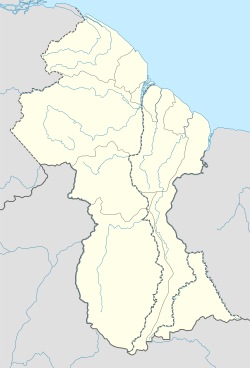Aishalton facts for kids
Quick facts for kids
Aishalton
|
|
|---|---|
|
Amerindian Village
|
|
| Country | |
| Region | Upper Takutu-Upper Essequibo |
| Sub-section | South/Deep South |
| Area | |
| • Total | 166 sq mi (430 km2) |
| Elevation | 614 ft (187 m) |
| Population
(2012)
|
|
| • Total | 1,069 |
| • Ethnicities | Wapishana |
Aishalton is a village in southern Guyana. It is home to the Amerindian people. The village is located in the Rupununi savannah. This area is part of the Upper Takutu-Upper Essequibo Region (Region 9).
Aishalton is an important center for the southern part of Region 9. In 2012, a count showed that 1,069 people lived there. This made it the third largest village in Region 9. It was also the biggest village in the southern sub-district.
Contents
History of Aishalton
Ancient Rock Art: The Aishalton Petroglyphs
Makatau mountain is about 3 kilometers from Aishalton village. It is a very famous place for archaeology in Guyana. Many ancient rock carvings, called petroglyphs, are found there. Locals call these carvings "timehri."
In the 1970s, a Guyanese expert named Denis Williams studied the area. He found 686 petroglyphs. These carvings mostly show humans, animals, plants, and shapes. Williams believed the carvings were made between 3000 and 5000 BCE. He said they had a special style, now called the "Aishalton type."
Williams also found 84 stone tools used to make the carvings. These were the first tools of their kind found in Guyana.
Where is Aishalton Located?
Aishalton village is in the Rupununi savannahs in southern Guyana. It is 187 meters above sea level. Nearby villages include Karaudarnau to the west and Awarewaunau to the east.
Lethem is the main town of the Upper Takutu-Upper Essequibo region. It is about 180 kilometers northwest of Aishalton. The Dadanawa Ranch is about halfway between these two places.
Getting to Aishalton: Transport Routes
The main way to travel between Aishalton and the coast of Guyana is the Linden-Lethem Road. This road is not paved. The coast is where most people in Guyana live, including the capital city, Georgetown.
From Lethem, people use private cars to travel the 180-kilometer dirt road to Aishalton. There used to be a bridge called the Rupununi River Bridge at Katoonarib. It helped people cross between Aishalton and Lethem. However, the bridge broke down in 2008.
In the 1990s, an airport runway was built in Aishalton. The Aishalton Airport has the airport code AHL.
Village Services and Facilities
Aishalton has a Rural Library Centre. It opened in 1976. This was part of the National Library of Guyana's plan to offer library services in more rural areas.
The Aishalton District Hospital opened in 1982. It is the only hospital in the southern part of Region 9. The hospital serves more than seven villages. Each day, 20 to 40 patients visit for care. About 20 patients are admitted each month. The hospital has about 18 staff members.
Aishalton has both a primary school and a secondary school. Aishalton Secondary School opened in 1999. It serves six villages in the South sub-section of Region 9. In 2009, the secondary school was reported to have many students.
An internet service came to the village in the 1990s. Before the internet, people used radio to communicate. There is no telephone service in Aishalton or nearby areas.
People and Culture
Most people in Aishalton are Wapishana Amerindians. The last few people who speak the Taruma language also live in this area.
The main religion in the village is Christianity. Most people are Roman Catholics. Smaller groups are Pentecostal Christians, Seventh-day Adventists, and Anglicans. A very small number of people follow Hindu and Muslim faiths.
The main ways people make a living are farming, fishing, and working with wood.
August Games and Local Traditions
Every year, Aishalton takes part in the August Games. This is a sports festival for the six villages in the southern part of Region 9. The games started in 1995. They include football, softball cricket, and volleyball.
On the last day, there are competitions to celebrate the Wapishana way of life. These include traditional Wapishana activities like grating cassava and ant-stinging.
Local food shows the traditional Wapishana culture. Cassava is a main food used in cooking. It is used to make cassava bread, a sauce called cassareep, and farine (like cous-cous). An alcoholic drink called parakari is also made from cassava. Making parakari is a complex process with many steps. It uses a special way of fermenting. This drink is the only known fermented drink made by indigenous peoples of the Americas that uses this type of fermentation.
See also
 In Spanish: Aishalton para niños
In Spanish: Aishalton para niños


